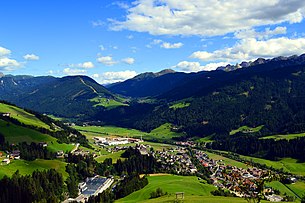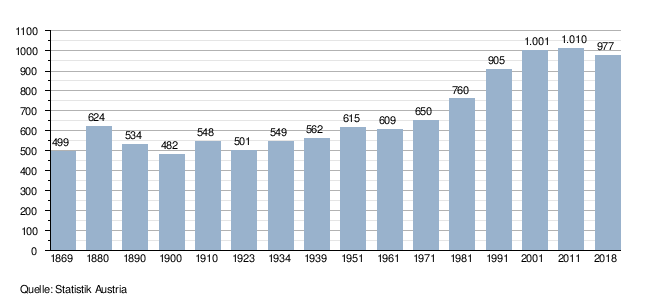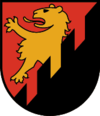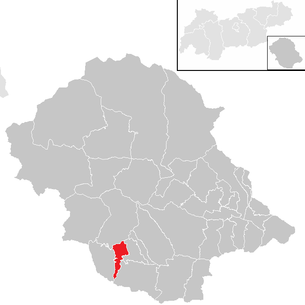Heinfels
|
Heinfels
|
||
|---|---|---|
| coat of arms | Austria map | |
|
|
||
| Basic data | ||
| Country: | Austria | |
| State : | Tyrol | |
| Political District : | Lienz | |
| License plate : | LZ | |
| Surface: | 14.56 km² | |
| Coordinates : | 46 ° 46 ' N , 12 ° 26' E | |
| Height : | 1078 m above sea level A. | |
| Residents : | 992 (January 1, 2020) | |
| Population density : | 68 inhabitants per km² | |
| Postal code : | 9919 | |
| Area code : | 04842 | |
| Community code : | 7 07 35 | |
| NUTS region | AT333 | |
| UN / LOCODE | AT HFS | |
| Address of the municipal administration: |
Panzendorf 126 9919 Heinfels |
|
| Website: | ||
| politics | ||
| Mayor : | Georg Hofmann (community Tessenberg) | |
|
Municipal Council : (2016) (13 members) |
||
| Location of Heinfels in the Lienz district | ||
 View from the northwest to Panzendorf with Heinfels Castle |
||
| Source: Municipal data from Statistics Austria | ||
Heinfels is a municipality with 992 inhabitants (as of January 1, 2020) in the Tyrolean district of Lienz . The community is located in the judicial district of Lienz .
geography
Heinfels lies at the confluence of the Drau with the Villgratenbach at 1078 m above sea level. A. , whereby the municipality includes parts of the Pustertal and the lower Villgratental . In the north of the municipality are the sunny slopes of the Villgrater mountains below the Tessenberger See, in the south there is the shady Kaserbach valley , which belongs to the Carnic Alps . The highest point of the municipality is the Hollbrucker Eck ( 2573 m above sea level ), the lowest point of the municipality is in the area of the Drau on the municipality border to Strassen at around 1069 m above sea level. A. Neighboring communities of Heinfels are Sillian in the west, Auservillgraten in the north, Strassen in the east and Kartitsch in the southeast.
Community structure
The municipality of Heinfels consists of the cadastral communities Panzendorf in the western municipality and Tessenberg in the northeastern municipality, with Panzendorf with a size of 866.91 hectares being significantly larger than Tessenberg with 589.35 hectares. In 2001 Panzendorf comprised 765 people and 223 buildings, Tessenberg 232 people and 67 buildings.
In the cadastral community of Panzendorf, the village of Panzendorf forms at 1078 m above sea level. A. the main settlement. It is located on the left and right banks of the Villgratenbach in front of the confluence with the Drau, a distinction being made between the district of Panzendorf, which is almost exclusively on the left bank of the Villgratenbach, and the newer settlement areas Aue and Blumaue to the south. Above or north of Panzendorf is the Heinfels Castle, and to the northwest is the Schlossmühle district on both sides of the Villgratenbach. Another newer settlement area is the Hinterheinfels settlement at 1200 m above sea level. A. , to which the scattered settlement Heinfelsberg, 1150 m above sea level , is located on the sunny slopes to the north . A. connects. Within the scattered settlement, a distinction is made between the Rotten Rain and Huben, west of the Gaisbach, and the group of houses, the Rießerhöfe, to the east. To the west of Panzendorf, on the other hand, is the Faider farm. To the south of Panzendorf and south of the Drau there is also a new development area, the Rotte Rabland, which is connected to the Kolechen farm to the south. Also on the shady side of the valley on the border with Sillian or west of the Kaserbach is the hamlet of Gschwendt at 1207 m above sea level. A.
The village of Tessenberg is the only larger settlement in the Tessenberg cadastral community. Only north of Tessenberg is the small Rotte Oberberg on the sunny slopes. In addition, the St. Johannes Church, which is slightly outside the village, and the Tessenberger Almrast alpine inn are also part of Tessenberg.
topography
The Drau was only able to form a narrow valley in the Heinfels municipality, into which the Villgratenbach flows from the north. This also forms the eastern border to the community of Ausservillgraten. The Bösenbach and Tiefenbach brooks, which run westwards, flow into the Villgratenbach in the municipality, whereby the Tiefenbach also marks the northern border to Auservillgraten. In addition, the Gaisbach, which runs from north to south, drains shortly before its confluence with the Villgratenbach, with Panzendorf being built on the rubble cone of Villgratenbach and Gaisbach. Tessenberg, on the other hand, lies on the rubble cone of the Tessenbergbach, which flows into the Drau. The highest elevation in the north of the municipality in the area of the Villgrater Mountains is the Glinzzipf with the Tessenberger See at 2126 m above sea level. A.
In the south of the municipality, Heinfels only includes the Kaserbachtal, which runs from south to north, on whose southern extension the Hollbrucker Eck at 2573 m above sea level. A. lies. The Kaserbach flows into the Sägebach, which has its source in the municipality of Sillian and which flows into the Drava near Rabland.
history
In the 6th and 7th centuries Slavs and Avars invaded the Heinfels area again and again . The region was Christianized under the Bavarian Duke Tassilo III. The village names "Tessenberg" and "Tassenbach" are derived from him. Tessenperch was first mentioned in a document in 1266 and around 1300 there is the first mention of a farm in the Panzendorf area. The municipality of Ponzendorf was only mentioned in 1364 . The name of the community, Heinfels, comes from the local Heinfels Castle , the founding of which is attributed to the legend after the Huns . In fact, however, the castle was probably founded by the Avars. Over the centuries the name Hunnenvels eventually became Heinfels.
In 1974, by merging the communities of Panzendorf and Tessenberg, the community of Heinfels was created.
A partnership with the municipality of Oberderdingen (Baden-Württemberg, district of Karlsruhe) has existed since 1991 .


population
Population structure
In 2012 there were 1,007 people in the Heinfels community. According to the 2001 census at the end of 98.2% of the population were Austrian citizens (Tyrol: 90.6%); by the beginning of 2012, the value fell only insignificantly to 96.1%. In 2001, 98.5% of the population (Tyrol: 83.4%), 0.7% were Protestant, 0.2% had no religious denomination to the Roman Catholic Church .
The average age of the community population in 2001 was well below the national average. 25.5% of the residents of Heinfels were younger than 15 years (Tyrol: 18.4%), 58.5% between 15 and 59 years old (Tyrol: 63.0%). The proportion of residents over 59 years of age was 16.0%, below the national average of 18.6%. As a result, the average age of the population of Heinfels rose significantly. The proportion of people under the age of 15 fell to 16.9% as of January 1, 2012, while the proportion of people between 15 and 59 years of age rose to 66.6%. The proportion of people over the age of 59 rose slightly to 16.5%. According to marital status, in 2001 50.4% of Heinfels residents were single, 44.4% married, 3.7% widowed and 1.5% divorced.
Population development
The population of today's municipality of Heinfels fluctuated strongly between the second half of the 19th century and the 1930s, with a peak value of 624 people temporarily reached in the 1880 census. By 1900 the population sank to only 482 inhabitants, only to decrease or increase again from census to census. In 1934 there were 549 people in Heinfels, around 10% more than in the 1869 census , with almost continuous population growth as a result. Only in the 1950s did the population stagnate; Heinfels recorded the strongest increases between 1971 and 2001. During this period the community had a consistently positive birth balance of 9 to 14% and from 1971 to 1991 a positive migration balance of 5 to 10%. record. Only in the 1990s did the community lose more residents through emigration than they moved in. During the first decade of the 21st century, the population stagnated at a high level, with a peak of 1,036 inhabitants in early 2006. However, the positive birth balance was offset by a predominantly negative migration balance. Since 2009 the number of people leaving the community has increased so much that this can no longer be compensated for by the birth balance and the number of inhabitants is falling again.

coat of arms
The black battlements in the municipality's coat of arms indicate Heinfels Castle, which is the godfather of the municipality's name. The golden lion, heraldic animal of the Counts of Gorizia, heralds their former rule.
Culture and sights
economy
Workplaces and employees
The 2001 census of workplaces in Heinfels showed 38 workplaces with 616 employees (excluding agriculture), 95% of which were employed. The number of workplaces had risen by ten companies (plus 36%) compared to 1991, but the number of employees fell by 10 people (2%). The most important branch of the economy in 2001 was the production of goods with five companies and 419 employees (68% of the employees in Heinfels). On the other hand, the largest number of companies was found in the construction industry with nine companies, where 51 people were employed (8% of employees). In addition, trade with seven workplaces and 69 employees (11% of all employees) also played an important role. A branch of the company EGO from Oberderdingen (Baden-Württemberg, Germany) is located in Heinfels . A few years ago, the biscuit and wafer manufacturer Loacker from South Tyrol established a plant in Heinfels. In addition, a car workshop, a carpentry, a furniture store and an agricultural machinery company are located in Heinfels. A supermarket and a shopping center are available in the town center. The mail distribution center of the post office 9920 Sillian was relocated to Heinfels.
Of the 388 employed residents of Heinfels, 139 people were employed in Heinfels in 2001. 249 had to commute to work. Of the commuters, 29% had their place of work in neighboring Sillian and 24% in the Lienz urban center. A further 22% had found a job in the rest of the district, a further 12 or 7% commuted to North Tyrol or another federal state, and 14 of the residents had to commute abroad. On the other hand, 478 people commuted to the community in 2001, making Heinfels one of the few communities in East Tyrol with a positive commuting balance. Most of the commuters came from the communities of the Pustertal and Villgratental as well as from Lienz.
tourism
The tourism in Heinfels has an average economic importance for the community, whereby the tourism intensity is on the average of the district area, the number of overnight stays are among the highest in the Pustertal. Heinfels was able to count around 40,000 overnight stays in the 2011/12 tourism year. Heinfels recorded 19,721 overnight stays in the summer of 2012 and 20,272 overnight stays in the winter of 2011/12. For both the winter and summer seasons, Heinfels has recorded a sharp drop in the number of overnight stays since the turn of the millennium and has lost around a third of its overnight stays in the last decade. Like all other East Tyrolean municipalities, the municipality belongs to the Osttirol Tourism Association, with Heinfels being organized in the "Hochpustertal Holiday Region".
education
Regular school lessons have been documented in Panzendorf since 1804, with lessons taking place in Heinfels Castle until 1837. The first school building burned down in 1902, the new building suffered the same fate in 1938. The school building, which still exists today, was erected in 1939 like the previous building on the castle hill near the church and renovated or expanded between 1988 and 1989 and equipped with a gym. The elementary school, which has been called Volksschule Heinfels since 1974 , was run in two classes between 1948 and 1988; from autumn 1988 there were three classes, and from autumn 2000 even four classes. In Tessenberg, on the other hand, lessons were given for a long time by the chaplain in the local Widum. A school building of its own had only existed since 1923. In 1976 the school was moved to the expanded former parish hall. Between 1993 and 1994 the building was rebuilt and expanded. Since then, the school has been run partly in two classes in a special school organization. The Heinfels community is part of the catchment area of the Sillian secondary school. For further school attendance, the Heinfels children can also visit the grammar school, the commercial academy or the technical college in Lienz. The parish kindergarten was housed in the parish hall in 1974 and expanded to two groups in 1996. The kindergarten is also open in the afternoon three days a week and is closed during the school holidays.
Transport and infrastructure
Heinfels is connected to the regional and national road network by the Drautalstraße (B 100), whereby the Drautalstraße connects the municipality with Lienz in the east and Sillian in the west. The Tessenbergstrasse (L325), which connects Heinfels and Panzendorf from the Drautalstrasse with Tessenberg and Strassen on the sunny side of the Puster Valley, is of particular importance for the development of the municipality. Furthermore, the beginning of the Villgratentalstraße runs across the municipality of Heinfels and connects Heinfels / Panzendorf with the Villgratental and the municipalities of Auservillgraten and Innervillgraten .
The Drautalbahn originally ran through the municipality on the right bank of the Drau without stopping. In 2020 the Heinfels stop was built near Rabland .
Heinfels belongs to the Upper Puster Valley wastewater association. The wastewater association operates a wastewater treatment plant in Anras, which went into operation in 1990, which cleans the wastewater for eight communities and uses the Drau as a receiving water. The sewerage of the community of Heinfels was already completed in 2002, with the exception of a few individual objects, whereby 92% of the 290 objects producing wastewater were connected to the sewer system and the sewage treatment plant this year. The waste that arises in the community is disposed of by the Waste Management Association of East Tyrol (AWVO).
Safety and health
In Heinfels there is a volunteer fire brigade in both the Panzendorf district and in Tessenberg . The Tessenberg Voluntary Fire Brigade was founded in 1909. The first motor-driven pump could not be purchased until 1935, and in 1974 the fire brigade received a small fire engine from the Ford Transit brand for the first time. The fire station , built in 1959 and expanded several times, houses a vehicle and trailer parking space, a hose tower, a command room with Florian station as well as a breathing protection and technology room. FF Tessenberg has a fire engine and a portable pump trailer. The voluntary fire brigade Panzendorf was founded on October 28, 1906, whereby a fire in the elementary school Heinfels in 1938 destroyed all records of the FF Panzendorf. The fire station located at Villgratenbach houses a team transport vehicle , a small fire engine and a tank fire engine . With regard to the health system, Heinfels is organized in the social district of East Tyrolean Oberland together with the communities of Auservillgraten , Innervillgraten , Sillian , Strassen , Kartitsch , Obertilliach and Untertilliach . In the health district, for example, health services such as elderly and care help, home and household help, palliative care and family help are organized.
Clubs and organizations
- Volunteer fire brigade in the Panzendorf district
- Volunteer fire brigade in the Tessenberg district
- Company fire brigade from EGO Austria
- Heinfels music band
- Mixed choir association Heinfels
- Church choir Tessenberg
- Heinfels tradition group
- Rural youth organizations (Tessenberg and Panzendorf)
- Catholic church organizations (Tessenberg and Panzendorf)
- Gymnastics and Sports Union Heinfels
- Hochpustertal ski club
- Senior group Heinfels
Personalities
Honorary ring bearer of the Heinfels community
According to the date of the award: Johann Pitterl, VD Johann Auer, Anton Webhofer, Heinz Treffinger, Kom.-Rat Ing. Alfons Pucher, Franz Kofler, Ing. Karl Fischer, Johann Riedler
Honorary citizen of the Heinfels community
Heinz Treffinger, Herbert Aichner, Alfons Pucher, Franz Kofler, Peter Wierer, Peter Kofler, Cons. Anton Libiseller
Sons and daughters of the Heinfels community
- Franz Josef Kofler (1894–1961), priest, teacher, man of letters and beetle researcher
- Konrad Huber (* 1965), Roman Catholic theologian and university professor
- Bernhard Aichner (* 1972 in Innsbruck), writer and photographer
literature
- Hans Auer: Chronicle of the community of Heinfels. Heinfels 2005
- Catholic Tyrolean Teachers' Association (Ed.): District Studies East Tyrol. Innsbruck 2001
- Franz Josef Kofler: Rough sunny side. A childhood on a mountain farm. Innsbruck 2011
- Richard Schober: Chronicle of the community Heinfels (local chronicles No. 13). Innsbruck 1975
Web links
Individual evidence
- ↑ a b c d Statistics Austria community data from Heinfels
- ↑ State Statistics Tyrol (VZ 2001) ( Memento from September 21, 2013 in the Internet Archive ) (PDF; 4.1 MB)
- ^ Albert Male: Heinfels. P. 219
- ^ Community Heinfels - education
- ↑ Catharina Oblasser: A train station in which a train has never stopped. Tyrolean daily newspaper from January 20, 2020
- ↑ State of Tyrol, wastewater disposal in the Lienz district ( Memento from September 22, 2013 in the Internet Archive ) (PDF; 7.2 MB)
- ^ Social district Osttiroler Oberland






